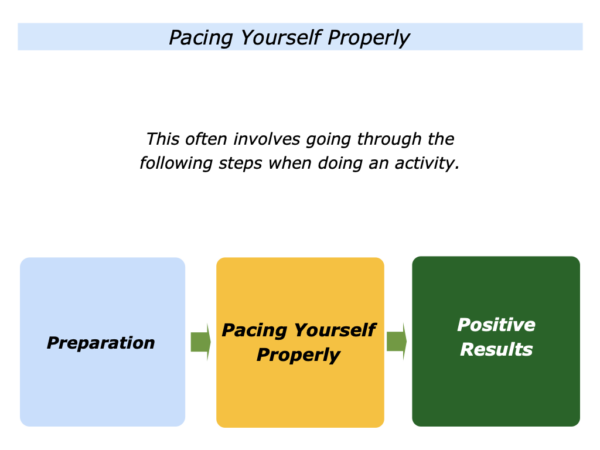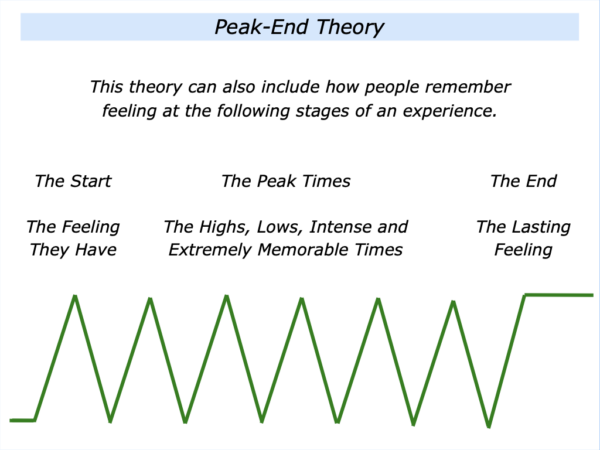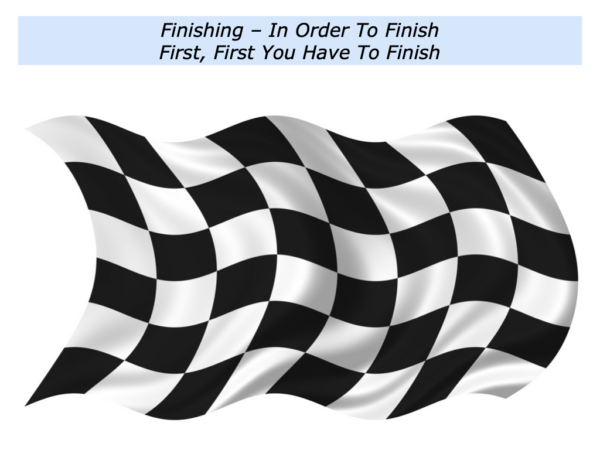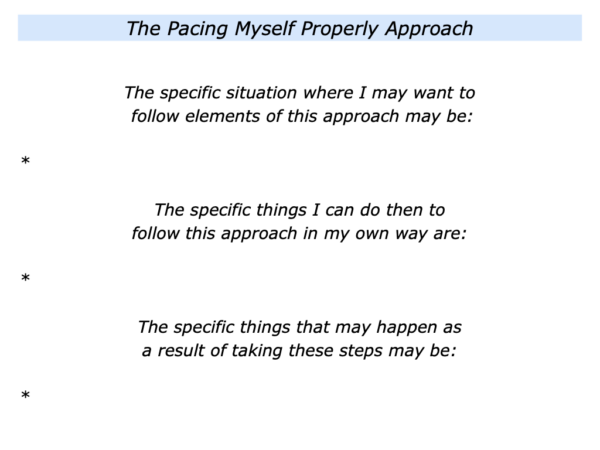
There are many ways to do fine work. One approach involves preparation and pacing yourself properly on the way to achieving positive results.
This approach can also be used to help other people. Each person has their own pace of doing things. It can be important to recognise and respect this when helping them to achieve a goal.
Looking back, can you think of a situation when you paced yourself properly? You may have been searching for a job, doing a creative project, tackling a challenge or doing another activity.
What did you do then to manage your energy both physically and psychologically? How did you pace yourself properly? What happened as a result of taking these steps?
Following Your Own Pace Successfully
People sometimes work best when they can set their own timetable. There may be situations, however, when they are working towards a deadline that is set by others.
Imagine that you are aiming to do piece of work in the future. This may involve going through the stages of preparation, pacing yourself properly and getting positive results. Let’s explore these themes.
Preparation
Great workers often start from their destination and work backwards. They go through the following steps:
They clarify the real results to achieve – the picture of success;
They clarify the strategies they can follow to give themselves the greatest chance of success;
They clarify the benefits of achieving the picture of success.
Such workers check their motivation to achieve the goals and make sure it is at least 7+/10. They also focus on how to can maintain or improve the rating.
Sometimes they do a piece of work even though the motivation rating is lower. They then actively choose to do it because it will help them to survive, thrive or work towards their lifetime goals.
Different people then plan their work in different ways. Some take the following approach:
They clarify their prime times – the times when they have most energy – and plan how to make the best use of these times;
They clarify how to organise their time in blocks – because this will give them the chance to do deep work;
They clarify their action plan – including the schedule they will follow – and aim to do their best to achieve the picture of success.
Such people try to make sure they have the resources required to do the job. They also clarify how they can get some quick successes and encourage themselves on the journey.
Great workers may then take time to relax and rehearse what they are going to do. They rehearse how they can aim: a) to follow their chosen strategies; b) to manage any potential challenges on the way.
Pacing Yourself Properly
Imagine that you are doing a piece of work. You will follow your own ritual for moving into action. You may then go through the stages of absorption – immersing yourself in the work – adventure and achievement.
You may also aim to go at your chosen pace. Sometimes you may do things slowly, sometimes you may do things quickly. Sometimes you will take time to rest and reflect before rehearsing what you are going to do next.
Great workers aim to follow their chosen rhythm. They take this approach when doing a piece of work, playing a sport, pursuing a creative project or doing another activity.
Such workers also recognise they may sometimes need to alter their pace in order to deliver the goods to other people. They aim to follow their own rhythm but also, when appropriate, do what is required to meet the required deadlines.
Different people have different approaches to how they manage their energy when doing a piece of work. The following pages explore some of these approaches.
The Front Loading Approach
Great workers sometimes start by doing an enormous amount of front loading. This can take different forms and depends on the field in which they perform.
One freelancer aimed to bring in more than 60% of their desired income during the first six months of the year. This provided a platform for them to keep following their principles and get positive results.
One mediator began by meeting individuals before gathering people together. They showed respect to each person and clarified their aims. Bringing people together, they built on areas of agreement and got some early successes.
One person had a financial approach to front loading. They always earned enough money to pay for things before buying them. They felt more comfortable taking this approach and refused to go into debt.
The Motivating Yourself
In The Middle Approach
Great workers go beyond motivating themselves when beginning and finishing an activity. They also maintain high standards during the middle part of doing the work.
Different people motivate themselves in different ways at this point. Some do it by refocusing on the benefits of achieving the picture of success.
Great teams refocus on their purpose. Many teams returned to this approach during the Covid pandemic. One person described this in the following way.
“Our medical team found it tough during Covid. We were working long hours under arduous conditions but we all pulled together.
“We kept revisiting our purpose. This is to care for people and help them to be healthy. We reenergised ourselves by focusing on this calling and aimed to live it every day.”
One leader followed elements of this approach when preparing for a workshop with their leadership team. People had been working hard and had sometimes lost sight of their real goals.
The workshop gave them the opportunity to recentre and refresh themselves. Bearing this in mind, the leader sent the following message to people before the session.
Looking Forward To The Workshop
As you know, we are having a workshop next week. Looking ahead, I have set myself some goals for the day.
My goals are that at the end
of the day, people are saying:
“We have revisited our mission and had a chance to add our ideas to the picture of success.
“We have refocused on the strategies want to follow to translate the mission into action in our daily work.
“We are again feeling a sense of mission and want to spread the word to our people and the world.”
During the day I will be asking you to each contribute the ideas that you have: a) to build on the mission; b) to translate it into action; c) to maintain our health in the process.
At the end of the session I will be asking for mission holders who want to implement the various parts of the strategies. I will then give them the support they need to deliver the goods.
Let me know if there any other items – such as themes or challenges – you would like to add to the agenda. I look forward to seeing you on the workshop.
How to motivate yourself during the middle? One approach is: a) to recall what you have achieved so far; b) to remind yourself of the benefits of achieving the goals.
You can also keep reading reality. It can be helpful: a) to build on what is working; c) to improve in the other areas. You can then keep working towards toward achieving the picture of success.
Positive Results
Great workers are often good finishers in the areas where they excel. Such people embody some elements of what Daniel Kahneman called Peak-End Theory.

The theory says that, when looking back, people do not necessarily recall their feelings throughout an experience. Instead, they remember the way they felt at:
The peak times – the intense times – and the end of the experience.
The peak times may be pleasant or unpleasant. These are the memories that stay with us, as does the way we felt at the end of the experience.
An additional view is that people also remember how they felt at that start of an experience. For example, whether the start was welcoming, enjoyable or difficult. This approach can be applied to how we remember, for example:
A relationship … A job we did at some point in our career … A sporting event, musical performance or other experience.
Many singers and other entertainers follow this approach. The old rules apply: Start Big – Give Lots Of Highs – End Big.
Great workers sometimes follow similar principles. They start well, maintain high standards and finish strongly. They aim to do this each day on the journey towards achieving their longer-term picture of success.
The Third Wind Approach
Some people follow an approach that is borrowed from athletics. This involves going beyond having a first and second wind. It involves going into another dimension and experiencing a third wind.
Jason Saltmarsh described one approach in an article he wrote for the Huffington Post called The Zen Of Running: Catching Your Third Wind. Here is an excerpt from the piece.
Most runners are familiar with the feeling of catching your second wind. It usually happens 10 to 15 minutes into a run.
After clearing out the initial aches, pains and tightness from previous runs, the body begins pumping more blood into the working muscles and warming up until perspiration begins.
The running suddenly feels a bit easier, and the runner usually responds by increasing their pace. This is, of course, why warming up properly before a race is so important. For runners that stick it out a bit longer, a third wind awaits.
For me, this usually happens around mile 5 or 6. I find myself slide into a hypnotic rhythm of footfalls and exhales, and my mind starts to entertain itself in other ways.
I’ll suddenly have an epiphany concerning a project at work, or I’ll find a solution to a problem that I’ve been struggling with, or I might begin writing a new article in my head.
Finally, it can be worth remembering a phrase about finishing that is used in Formula 1 Racing. In order to finish first, first you have to finish. You will do this in your own way to achieve positive results.

Helping Other People To
Follow Their Pace Successfully
Every person has a different pace of working. Sometimes it can be useful to help them to find and follow their chosen pace. Let’s look at one example.
Jeff was the Chief Operating Officer for a company. He saw himself as a creative engineer, however, who did more than solve problems. He enjoyed designing systems that would enable people to achieve success.
Moving into his present role had produced several challenges. The first involved splitting the role into three segments. These called for organising his time into the following areas:
To stay close to his key stakeholders – such as the CEO – and take responsibility for translating their strategies into action;
To build a self-managing operations team that ensured the company’s engine ran superbly every day;
To create free space to be able to deal with any unexpected events and design new systems that would help the company to achieve success.
Jeff saw how this approach would help to him to make his best contribution. He needed to find a good deputy, however, and also provide the support required for his team to become more self-managing.
He already had a good relationship with the CEO, who tended to use him as his Chief of Staff. But he also needed to create time to deal with crises and create new systems that would benefit the business.
Jeff then raised another point. During a previous session we had discussed the concept of prime times – the times when he had most energy. He explained his challenge in the following way.
“I have always been a late afternoon and evening person. This is when I feel most creative, but therein lies a problem. My role calls for me doing a lot of work from 8.00 am onwards.
“I have tried to change my routines by going to bed early and even going to the gym in the morning, but I am still at my best after 3.00 pm in the afternoon. Have you any suggestions?”
Jeff was based in Europe and had several options. These included: a) Staying in his present role; b) Running the European arm of a US company; c) Moving to a role where he had more control over his time.
He wanted to stay in his present role, however, and give it his best shot. There were several things he could do to make his best contribution. These included taking the following steps.
Accepting His
Preferred Working Pattern
One approach was for Jeff to accept his preferred working pattern – which may become more pronounced as he got older. The aim would be to apply it in the best way.
This approach involved clarifying two things. First, how to build on the pluses of his preferred working style. Second, how to manage the consequences of any potential minuses.
Jeff found this approach to be quite liberating. He could aim to be super professional during the hours between 8.00 and 15.00. Then, if appropriate, he could aim to do creative work later in the day.
Making Good Use Of His
Preferred Working Pattern
Looking ahead, Jeff clarified how to make good use of his preferred working pattern. This involved focusing on following themes.
Preparation
Jeff could be proactive and prepare properly. This would involve taking the following steps. He could continue:
To meet with the key stakeholders to clarify the specific help they may need from the operations team in the next day, week and month;
To help his operations team to plan: a) how to help the stakeholders to achieve their aims; b) how to manage any potential challenges;
To set aside time to do creative work on designing systems that would help the company to achieve future success.
Professionalism
Jeff would continue to be disciplined and professional in his daily work. This was an approach he had learned when competing in athletics at a national level. He explained this in the following way.
“There is an old saying in sports that: ‘Hard work beats talent when talent does not work hard.’ I was reasonably good but there were others who had much more talent.
“Bearing this in mind, I kept following certain disciplines to apply my talent. This called for preparing properly and aiming to do my best on the day.
“This is a pattern I have also followed in my career. I aim to be polite, professional and deliver positive results. This is something I will continue to do during my working days.”
Peak Performance
Jeff felt able to run the operations aspect of the business. Recruiting a good deputy would be paramount, however, as would educating the team to become more self-managing.
He could also allocate time to designing and delivering systems that would help the business to achieve future success. This was the activity where he could deliver his equivalent of peak performance.
Jeff was not worried about doing this on top of the other aspects of the COO role. He explained this in the following way.
“Whatever has happened before, I tend to get a new burst of energy from the late afternoon onwards. Whenever possible, I will set aside time from then to 18.00 to work on the creative projects.
“Looking back at my history, I know this approach works. Sometimes I also get creative ideas into the night. I will need to note these down and try them later the following day.”
He translated this approach into action. Sometimes he lagged a little in the middle of the day but then went for a short walk. He was still available on the phone, of course, but found this helped to reboot his energy.
Jeff was a realist, however, and recognised that at some point it may be advisable to seek another role. This would be one where he could be more in charge of his schedule. But for the moment he continued to make a fine contribution to the company.
There are many ways to do fine work. One approach is to do the preparation and pace yourself properly on the way towards achieving the desired positive results.
Looking ahead, can you think of a situation where you may want to follow elements of this approach? This could be in your personal or professional life. How could you follow this approach in your own way?
If you wish, try tackling the exercise on this theme. This invites you to complete the following sentences.







Leave a Reply